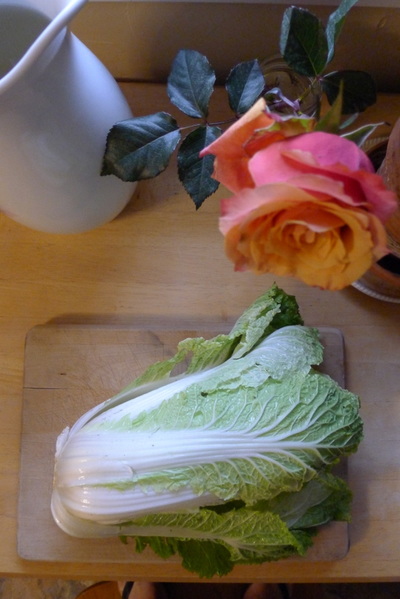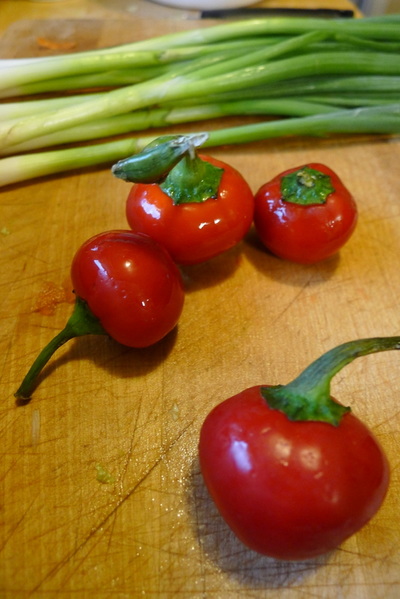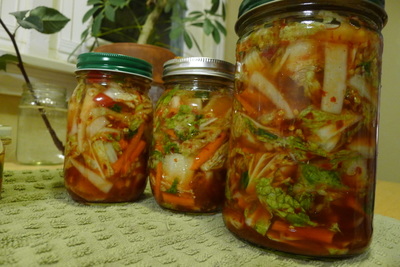|
We eat our fair share of yogurt for probiotics, but I love and crave fermented veggies. Unfortunately, they are often quite pricey, so I figured that fermenting our own was a good thing to do with my funemployment time. I've heard that my maternal grandmother always had sauerkraut working in her kitchen, which I'll have to try next. Round Two of making Kimchi in an effort to increase probiotic variety is somewhat based on what was in our fridge and pantry and somewhat based on what could have gone better the last time. The fermentation is a bit aromatic, but I figured I might as well go for it because of all the hard cider we already have fermenting by the wood stove. Also, I like to be as cool as possible and kimchi is hot right now: #kimchikool This recipe is a combination of a few I liked that had similar ingredients to what I could scrounge up. One is nice and quick from The Kitchn, another by The Splendid Table with a few tips from Crazy Korean Cooking. Isn't napa cabbage beautiful? The rose is courtesy of the ever romantic, Subaru dealership. Ingredients: 1 head of napa cabbage 1/2 of a daikon 4 green onions 3 carrots 4 small peppers of your choice (I used cherry bird peppers) 2 tbs grated garlic 2tbs grated ginger 4 table spoons crushed red pepper (**most Korean kimchi recipes call for Korean hot pepper flakes (gochugaru), but I didn't find it at Wegman's and I have yet to go to the asian market. 4 tbs fish sauce 1tbs sugar 1/2 cup coarse sea salt Steps and Tips: 1. Prep Veg: Wash and drain cabbage and other vegetables. 2. Cut cabbage into quarters and those quarters in to 2 inch squares and place into a bowl with sea salt and enough water to cover the mixture. I let this sit for 3-4 hours. 3. Chop daikon and carrots into matchsticks, dice pepper, and grate ginger and garlic. 4. Blend paste with the ginger, garlic, hot pepper flakes, fish sauce and sugar. 5. Drain and squeeze the cabbage and taste it to check the saltiness (retain some of this salt water brine to top off your jars). If it seems too salty for your liking, rinse the cabbage until you have optimal or slightly salty cabbage (some of the saltiness goes away in fermentation). 6. Combine the other veggies with the cabbage and mix in the paste while giving everything a nice massage. 7. Stuff the concoction into some kind of container (I use glass jars because that's what I have). Fill jars to within a half inch of the top and then pour brine in the jar until it covers the mixture. 8. Place lids on top of the jars, but DO NOT TIGHTEN. These gassy little jars will need to breathe as they work. 9. Nestle the jars on something that will capture liquid if they bubble over and place in a dark area. 10. Fermentation time! Allow this to sit out for 1-5 days until your desired ripeness. 11. Upkeep: check the mixture daily and use a clean spoon or chopstick to press the veggies back down into the jar. The fermentation process causes gas to release and push the veggies up. 12. Refrigerate after it has reached the potency you desire and keep it sealed up tight (in Korea people actually have kimchi refrigerators to not only maintain the perfect temperature, but to quarantine the smell). 13. Enjoy! We like to add our kimchi to everything from plain rice to grilled brauts. Feel confident that you are making your gut very happy! |
Archives
July 2018
Categories
All
|












 RSS Feed
RSS Feed
